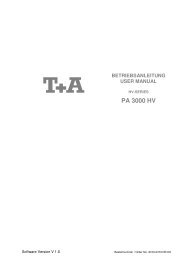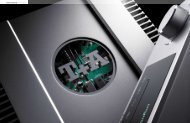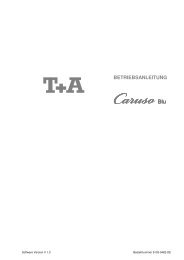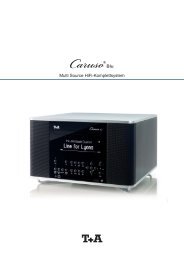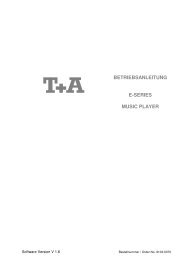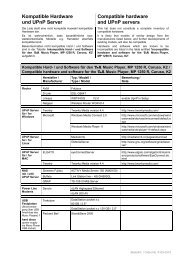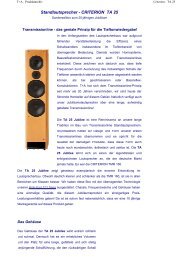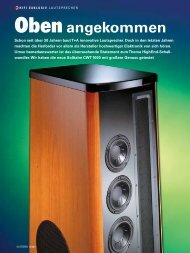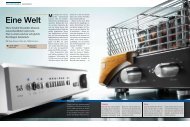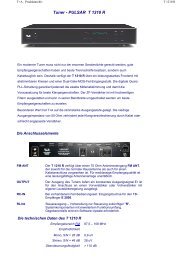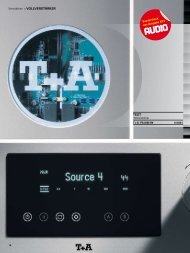CD player - PULSAR CD 1500 R - T+A Elektroakustik
CD player - PULSAR CD 1500 R - T+A Elektroakustik
CD player - PULSAR CD 1500 R - T+A Elektroakustik
You also want an ePaper? Increase the reach of your titles
YUMPU automatically turns print PDFs into web optimized ePapers that Google loves.
<strong>T+A</strong> - Produktarchiv<br />
and resolution in the treble range.<br />
In the D/A conversion section of the <strong>CD</strong> <strong>1500</strong> R the frequency spectrum is divided up into<br />
two part-ranges, each of which is processed by its own set of converters.<br />
The advantage of this technique is that each part of the frequency range is processed by the<br />
converter technology best suited to it.<br />
BURR-BROWN multi-bit converters (maximum K selectivity) for the bass range<br />
NPC Sigma/Delta converter for the mid-range / treble range<br />
This complex arrangement combines the positive qualities of multi-bit converters (tight,<br />
rounded, powerful bass) with the complementary features of fine detail resolution and low<br />
distortion which are characteristic of Sigma/Delta converters.<br />
In both cases these converters are implemented in the form of complex double-differential<br />
circuits. This type of circuit design requires a total of eight individual converters, but the<br />
outstanding dynamics and overall reduction in hiss and harmonic distortion are so<br />
impressive that they easily justify the extra complexity.<br />
Analogue filters<br />
The analogue section of the <strong>CD</strong> <strong>1500</strong> R features a consistent policy of symmetrical,<br />
channel-separate (double-mono) construction. Channel symmetry is maintained throughout<br />
the circuit, and is established at the digital level where there is no chance of phase errors.<br />
The advantage of this arrangement is that a symmetrical signal is generated without the<br />
danger of introducing phase and amplitude errors.<br />
All four converters on each channel are operated in the optimum double-differential mode,<br />
which reduces the hiss level of the converters by an additional 3 dB.<br />
However, we have maintained the symmetrical construction even in the analogue<br />
reconstruction low-pass circuits, the volume control and the output stages.<br />
The advantage of this sophisticated type of circuit design lies in the fact that no earth<br />
currents are present in the filter stages or the output and control stages, with the result that<br />
the analogue signal earth stays extremely clean.<br />
Output stages<br />
We have developed a new circuit for our output stages:<br />
We have abandoned the use of standard operational amplifiers (op-amps) in favour of a<br />
combination of a high-quality BURR-BROWN audio op-amp followed by a driver amplifier<br />
(BURR-BROWN BUF 634 T).<br />
The driver amplifier features very high bandwidth (180 MHz), high slew rate (1800 V/µ s)<br />
and good current supply capacity (250 mA).<br />
These characteristics mean that it can drive practically any cable of any length.<br />
This in turn means that the audio op-amp is relieved of the stress of driving the capacitive<br />
load represented by the cable, and therefore works even more accurately than in a standard<br />
configuration.<br />
<strong>CD</strong> mechanism<br />
The machine is based on a close-tolerance linear drive mechanism, now combined with an<br />
<strong>CD</strong> <strong>1500</strong> R



